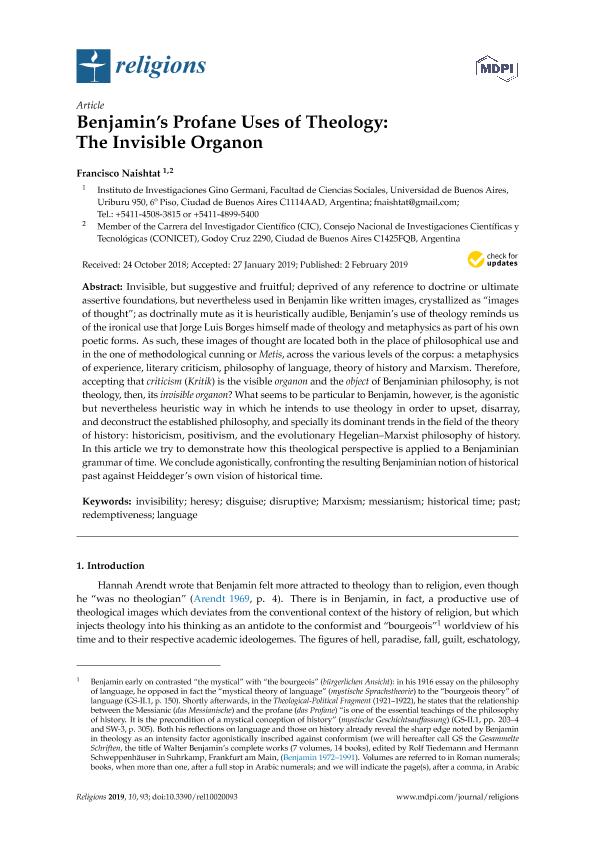Mostrar el registro sencillo del ítem
dc.contributor.author
Naishtat, Francisco

dc.date.available
2021-02-11T01:27:47Z
dc.date.issued
2019-02
dc.identifier.citation
Naishtat, Francisco; Benjamin’s profane uses of theology: The invisible organon; Multidisciplinary Digital Publishing Institute; Religions; 10; 2; 2-2019; 1-16
dc.identifier.uri
http://hdl.handle.net/11336/125373
dc.description.abstract
Invisible, but suggestive and fruitful; deprived of any reference to doctrine or ultimate assertive foundations, but nevertheless used in Benjamin like written images, crystallized as “images of thought”; as doctrinally mute as it is heuristically audible, Benjamin’s use of theology reminds us of the ironical use that Jorge Luis Borges himself made of theology and metaphysics as part of his own poetic forms. As such, these images of thought are located both in the place of philosophical use and in the one of methodological cunning or Metis, across the various levels of the corpus: a metaphysics of experience, literary criticism, philosophy of language, theory of history and Marxism. Therefore, accepting that criticism (Kritik) is the visible organon and the object of Benjaminian philosophy, is not theology, then, its invisible organon? What seems to be particular to Benjamin, however, is the agonistic but nevertheless heuristic way in which he intends to use theology in order to upset, disarray, and deconstruct the established philosophy, and specially its dominant trends in the field of the theory of history: historicism, positivism, and the evolutionary Hegelian–Marxist philosophy of history. In this article we try to demonstrate how this theological perspective is applied to a Benjaminian grammar of time. We conclude agonistically, confronting the resulting Benjaminian notion of historical past against Heiddeger’s own vision of historical time.
dc.format
application/pdf
dc.language.iso
eng
dc.publisher
Multidisciplinary Digital Publishing Institute
dc.rights
info:eu-repo/semantics/openAccess
dc.rights.uri
https://creativecommons.org/licenses/by/2.5/ar/
dc.subject
DISGUISE
dc.subject
DISRUPTIVE
dc.subject
HERESY
dc.subject
HISTORICAL TIME
dc.subject
INVISIBILITY
dc.subject
LANGUAGE
dc.subject
MARXISM
dc.subject
MESSIANISM
dc.subject
PAST
dc.subject
REDEMPTIVENESS
dc.subject.classification
Otras Filosofía, Étnica y Religión

dc.subject.classification
Filosofía, Ética y Religión

dc.subject.classification
HUMANIDADES

dc.title
Benjamin’s profane uses of theology: The invisible organon
dc.type
info:eu-repo/semantics/article
dc.type
info:ar-repo/semantics/artículo
dc.type
info:eu-repo/semantics/publishedVersion
dc.date.updated
2021-02-09T18:44:03Z
dc.identifier.eissn
2077-1444
dc.journal.volume
10
dc.journal.number
2
dc.journal.pagination
1-16
dc.journal.pais
Suiza

dc.journal.ciudad
Basilea
dc.description.fil
Fil: Naishtat, Francisco. Universidad de Buenos Aires. Facultad de Ciencias Sociales. Instituto de Investigaciones "Gino Germani"; Argentina. Consejo Nacional de Investigaciones Científicas y Técnicas; Argentina
dc.journal.title
Religions
dc.relation.alternativeid
info:eu-repo/semantics/altIdentifier/url/https://www.mdpi.com/2077-1444/10/2/93
dc.relation.alternativeid
info:eu-repo/semantics/altIdentifier/doi/https://doi.org/10.3390/rel10020093
Archivos asociados
